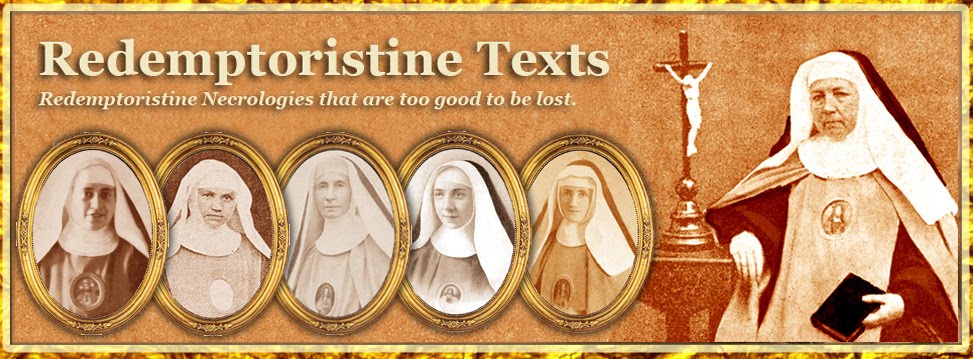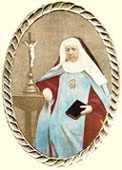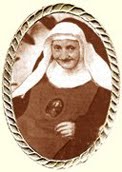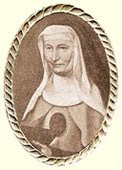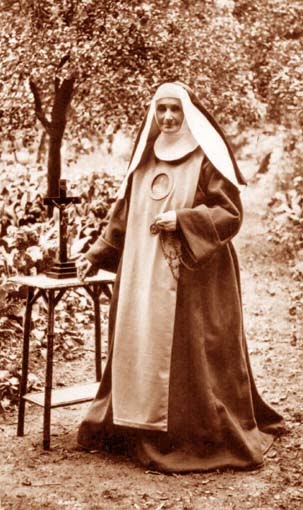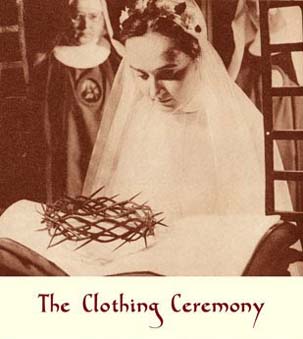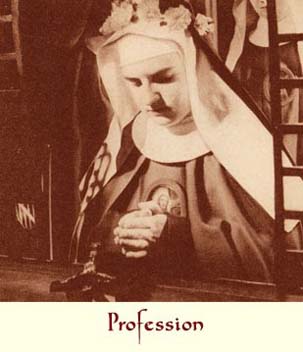Foundation of the Monastery of Dublin
CHAPTER I. CHILDHOOD OF JULIE VERHELST.
She enters the convent of the Redemptoristines at Bruges
CHAPTER I. CHILDHOOD OF JULIE VERHELST.
She enters the convent of the Redemptoristines at Bruges
She was indeed a charming child, this little Julie Verhelst who, in 1830, when she was scarcely four years old, was brought to the church on Christmas day at the very moment when the great bell announced the midnight Mass. She knelt down on the pavement, as if totally penetrated already by the grandeur of the mystery that was being celebrated, and prayed fervently. A little later, endowed as she was with a rare intelligence, an admirable uprightness of heart, and a profound piety, she watched so well over her two young brothers and her four sisters that when she was present, they did not dare permit themselves the smallest lie or the least evasion. It was indeed one of the characteristic features of her life. Her soul was always as pure as crystal, and the truth shone forth in all her actions.
Julie Verhelst was born in Courtrai in 1826, of well respected and perfect Christian parents. Through her agreeable nature, her charming pleasantries, and the happy company in her of the rarest qualities of mind and spirit, she was soon the delight of her parents and family. But the Spouse of Virgins was very soon to reserve this chosen soul for Himself. From her first communion in 1837, the sweet child felt a keen attraction to the religious life. The excellent education she received confirmed her in this thought; and when Father Paul Reyners, Redemptorist, made her aware, in the course of a retreat, of the existence of the Order of the Redemptoristines, she felt God calling her to be one of the daughters of Saint Alphonsus. The religious who was then governing the Redemptoristine Convent of Bruges was called Sister Marie-Alphonse of the Will of God. It was she who welcomed the young lady’s first overtures. And she in turn was greatly impressed by this interview. “I believed I was in the presence of Saint Teresa”, she told her mother, “so struck was I by the greatness of her soul and the profound faith with which she spoke of the greatness of the religious vocation.” Mother Marie-Alphonse promised the postulant she would receive her as soon as the will of God became manifest and certain obstacles overcome. Providence did not delay in opening the way.
On 2nd July of the year 1845, on the feast of the Visitation of the Most Holy Virgin, Julie-Marie-Josephine Verhelst, in company of four other young ladies of good family, trampled with their feet on the greatness of the world with its deceptive charms, and took this first step in one day becoming the brides of Christ, their only love. This was at the monastery of Bruges. After greeting them, the Venerable Fr. Joseph Passerat spoke to them in detail; then he led the postulants to the door of the enclosure, took it upon himself to knock on it for them, and when Mother Marie-Alphonse had made the customary demands, he introduced them into the monastery to the chant of In exitu Israel de Aegypto [On the exit of Israel from Egypt].
The ceremony for the taking of the habit took place for the five candidates one year later, that is, on 22nd July 1846: all of them had given brilliant proof of their virtue, but she who was later to be called Sister Mary-Jean of the Cross stood out from all the others by her blind obedience, her spirit of sacrifice, and a piety so full of grace and unction that one could not help feeling attracted to her. The Bishop of Bruges was the celebrant, and after a special sermon given by Fr. Joseph Reyners, he blessed the white veils and the holy habit, and presented them to the novices by saying: “May the Passion of Our Lord Christ be stamped on your heart and in all your senses.”
The generous Novice then saw the path of the actual novitiate open up before her. Under the guidance of Mother Marie-Philomène, she made new and rapid progress in the practice of solid virtue. The Rule of the Redemptoristines requires them to imitate the virtues of the Most Holy Redeemer, reproduce His hidden life in Nazareth as much as possible in themselves, and participate by their prayers and their sacrifices in His apostolic life, for the great work of the salvation of the souls.
As humble as she was courageous, Sister Mary-Jean of the Cross did not place any limits to her ardour. Accustomed to doing nothing by halves, she continued to follow the royal path of complete devotion to her heavenly Spouse, and she always had a horror of the narrow calculations of a shared life, and a heart that is not all for God. “Virtue”, said Saint Mary-Magdalen of Pazzi, “has nothing feminine but the name, and taken in the sense of religious perfection, this word means heroism and complete immolation of self to be united to the divine model, Jesus crucified.”
This is indeed what our Novice had understood, so she was amply rewarded when, on 15th October 1847, she was permitted to pronounce the holy vows of poverty, chastity, obedience, and perpetual enclosure.
* * * * *
The obedience of the newly professed soon had occasion to be tested.
One day she went to ask Mother Marie-Alphonse for a book of spiritual reading, and received this reply from her Superior: “Certainly, but before I do so, you must learn the first eight chapters of Spiritual Combat by heart, and recite them to me”. Mother Mary-Jean of the Cross bowed her head, learned the eight chapters by heart, recited them, and then received a book of readings.
A more important occasion presented itself: it was about the tasks to be done. As Saint Alphonsus says, it is often something that causes the greatest problems to Superiors, because they do not always find obedient souls. The young professed did not seek anything and did not refuse anything, and when she was named assistant-bursar and portress, she fulfilled these functions with tact and a remarkable ability. The converse Sisters greatly liked and respected Mother Mary-Jean of the Cross, and they gave her all their confidence. This good Mother in fact regulated their different tasks so that they would all help each other with a quite fraternal charity. She herself would procure for each one of them what was necessary for her task, gladly took upon herself the writing of their letters, gave them their spiritual readings, and marvellously possessed the precious talent of restoring their spirits by one of those words that go straight to the heart. And so none of them ever recoiled before works most painful to nature, and their hearts rose effortlessly to God to offer Him lovingly the tribute of their obedience.
After one responsibility came another. The task of Housekeeper later on called forth the qualities of the Mother Mary-Jean of the Cross and that of Mistress of Novices showed she had a rare dexterity in the government of souls. “All the good of a convent”, said Saint Alphonsus, “depends on the education of the Novices, who eventually will have to govern it”. The good examples of the devout Mistress, her impartiality and her constancy in firmly instilling knowledge and observance of the Rule promptly won her the confidence and affection of her daughters. For in fact they were so, as their Mistress showed herself a vigilant and tender mother in regard to them, forming them little by little to solid virtue, and endeavouring to dilate and rejoice their hearts and make the yoke of the Lord seem sweet and soft to them. Thus the Monastery of Bruges had the happiness of possessing a number of fervid souls, delicious fruits, worthy of the tree that had born them.
The foundation of the Convent of Brussels-Malines took place in 1855. It was from Bruges, to the number of fourteen, that came the Redemptoristines who established it. Mother Mary-Jean of the Cross had no part in it; but in 1858, when it was proposed to open a new monastery at Velp, in Holland, it was she who was assigned to prepare it. Assisted by two converse Sisters, she set to work with her usual activity, and only a few weeks were sufficient for her to put the house in state to receive the Superior and the four Sisters designated for the foundation. When they arrived, they found the cells all ready, the chapel well prepared, the kitchen in order and the cellar itself abounding with provisions, but the Sister Procurator’s purse no longer contained even a cent, so much had she wanted to do everything well!
But there was now a new foundation that would require the care of Mother Mary-Jean of the Cross. This time, it is as Superior that she will appear to us. The tasks exercised by her up till now were all to prepare her for a more difficult and meritorious life still.
* * * * *
It was to Dublin, the capital of the island of the Saints, that the good Mother would be going to found a monastery of Rédemptoristines there. God wanted Ireland, this country so devoted to the Most Holy Redeemer and to His Most Holy Mother, to have its own Virgins consecrated to none other than the imitation of these two admirable models.
Recommended to Cardinal Cullen by the illustrious Mons. Malou, Bishop of Bruges, Mother Mary-Jean of the Cross departed from Bruges under the guidance of Reverend Mother Marie-Philomène, her Superior, with four Sisters intended to be the core of the nascent community. On 25th March 1859, on the feast of the Annunciation, the new arrivals were solemnly installed in their provisional home. Cardinal Archbishop, the Most Rev. Fr. de Held, Provincial of the Belgian Redemptorists, the Rev. Fr. de Buggenoms, Rector of Limerick, numerous priests and all the notabilities of Dublin, enhanced the ceremony by their presence. An eloquent sermon by Father de Buggenoms reviewed the merits of the contemplative life, and showed the happy fruits that it produces in the Church.
It was a great joy for the Sisters to see their number soon increasing. Fine vocations were declared straight away, including that of the eldest daughter of Mr. O'Brien. Her family was one of the most illustrious and revered in Ireland: it recalled the heroic times when the Catholics of this country had, at the cost of a thousand sacrifices, defended their faith and their priests against the most atrocious persecutions. Several others, in whose the veins the blood of the martyrs also flowed, joined themselves to her, and Mother Mary-Jean of the Cross soon understood that Heaven was for it, in the midst of the unavoidable contradictions that it had to undergo. Did she not know indeed, that in the cross is life, salvation, and resurrection? Saint Joseph, to whom she prayed with ardour, had he not sent her some unexpected help? Finally, in the very house where she lived, a good servant of God had once predicted that some cloistered nuns, dressed in red and blue, would come there to live one day.
These divine favours encouraged the Mother Superior, and thanks to her example and thanks to her exhortations, the new Monastery was soon established on the basis of the most perfect regularity. With her firm but gentle authority, she captivated all hearts, and knew, by a thousand means that only virtue knows, how to prepare them for the most generous sacrifices. Her attention to giving pleasure had the secrets and resources that a mother's heart alone can imagine. If a sister was sick, she did not leave her side and the physician could not give an order whose execution she did not supervise. If the illness was prolonged, she would ensure that the patient was not deprived of Holy Communion, and finally, when the death came to take away one of her daughters, she did not abandon her! Her faith and love followed the soul unto eternity, and she assured her of prompt and numerous suffrages.
The tender solicitude of Mother Mary-Jean of the Cross was given without distinction to all her Sisters. She sometimes even appeared to give a certain preference to the converse Sisters, placed great value on their work, praised their devotion, and most of all, never permitted them to be deprived of their spiritual exercises. “God”, she said, “must be served with great fidelity to everything that the Rule prescribes for the Converse as well as for the choir Sisters.” Thus she conformed herself to the recommendation so often made by Saint Alphonsus and so she maintained in her community the spirit of fervour, of mutual charity, and of the common imitation of the virtues of the Most Holy Redeemer.
The love of prayer and love of the Church soon became the soul of the new Monastery. It was the result of the example and exhortations of the good Superior. As a worthy daughter of the Doctor of prayer, she gave to this holy exercise every moment which she was able to find, and there was the secret of her power over God's heart and her influence over the hearts of those she governed. But her prayer was never a selfish prayer, either for herself, or for her daughters. Without forgetting the interests of their souls, these daughters learnt from their pious Mother to pray a great deal for the Church. With what care, for example, did they dedicate the prayers and good works of every day of the week to a completely apostolic intention! With what ardour did Mother Mary-Jean of the Cross remind them of these sublime intentions!
Let us permit ourselves to mention them here, as they show us what prayer is in contemplative monasteries, and the beauty of this life consecrated entirely to the good of others.
“On Sundays, all prayers, communions, penances and works will be offered for the Sovereign Pontiff, the exaltation of the holy Church, the Sacred College of Cardinals, all Prelates, the diocesan bishop, and all Christian Princes.
“On Mondays, for all sinners, heretics, Jews and pagans, so that they may attain the light of the true faith.
“On Tuesdays, for all Orders of religious men and women, so that the Lord may give them the spirit of their vocation.
“On Wednesdays, for all evangelical workers and for all fathers and mothers of a family.
“On Thursdays, for the four states of souls: for those who are in purgatory, for the innocents, for the agonising; for the children who are to be born, while asking for them to receive the grace of holy Baptism.
“On Fridays, for the perfection of our own community, and for the growth of the spirit of the Order and all its subjects.
“On Saturdays, for all the relatives of the Sisters, for our spiritual and temporal benefactors, and for all those who are devoted to the Most Blessed Virgin Mary.”
Julie Verhelst was born in Courtrai in 1826, of well respected and perfect Christian parents. Through her agreeable nature, her charming pleasantries, and the happy company in her of the rarest qualities of mind and spirit, she was soon the delight of her parents and family. But the Spouse of Virgins was very soon to reserve this chosen soul for Himself. From her first communion in 1837, the sweet child felt a keen attraction to the religious life. The excellent education she received confirmed her in this thought; and when Father Paul Reyners, Redemptorist, made her aware, in the course of a retreat, of the existence of the Order of the Redemptoristines, she felt God calling her to be one of the daughters of Saint Alphonsus. The religious who was then governing the Redemptoristine Convent of Bruges was called Sister Marie-Alphonse of the Will of God. It was she who welcomed the young lady’s first overtures. And she in turn was greatly impressed by this interview. “I believed I was in the presence of Saint Teresa”, she told her mother, “so struck was I by the greatness of her soul and the profound faith with which she spoke of the greatness of the religious vocation.” Mother Marie-Alphonse promised the postulant she would receive her as soon as the will of God became manifest and certain obstacles overcome. Providence did not delay in opening the way.
On 2nd July of the year 1845, on the feast of the Visitation of the Most Holy Virgin, Julie-Marie-Josephine Verhelst, in company of four other young ladies of good family, trampled with their feet on the greatness of the world with its deceptive charms, and took this first step in one day becoming the brides of Christ, their only love. This was at the monastery of Bruges. After greeting them, the Venerable Fr. Joseph Passerat spoke to them in detail; then he led the postulants to the door of the enclosure, took it upon himself to knock on it for them, and when Mother Marie-Alphonse had made the customary demands, he introduced them into the monastery to the chant of In exitu Israel de Aegypto [On the exit of Israel from Egypt].
The ceremony for the taking of the habit took place for the five candidates one year later, that is, on 22nd July 1846: all of them had given brilliant proof of their virtue, but she who was later to be called Sister Mary-Jean of the Cross stood out from all the others by her blind obedience, her spirit of sacrifice, and a piety so full of grace and unction that one could not help feeling attracted to her. The Bishop of Bruges was the celebrant, and after a special sermon given by Fr. Joseph Reyners, he blessed the white veils and the holy habit, and presented them to the novices by saying: “May the Passion of Our Lord Christ be stamped on your heart and in all your senses.”
The generous Novice then saw the path of the actual novitiate open up before her. Under the guidance of Mother Marie-Philomène, she made new and rapid progress in the practice of solid virtue. The Rule of the Redemptoristines requires them to imitate the virtues of the Most Holy Redeemer, reproduce His hidden life in Nazareth as much as possible in themselves, and participate by their prayers and their sacrifices in His apostolic life, for the great work of the salvation of the souls.
As humble as she was courageous, Sister Mary-Jean of the Cross did not place any limits to her ardour. Accustomed to doing nothing by halves, she continued to follow the royal path of complete devotion to her heavenly Spouse, and she always had a horror of the narrow calculations of a shared life, and a heart that is not all for God. “Virtue”, said Saint Mary-Magdalen of Pazzi, “has nothing feminine but the name, and taken in the sense of religious perfection, this word means heroism and complete immolation of self to be united to the divine model, Jesus crucified.”
This is indeed what our Novice had understood, so she was amply rewarded when, on 15th October 1847, she was permitted to pronounce the holy vows of poverty, chastity, obedience, and perpetual enclosure.
* * * * *
The obedience of the newly professed soon had occasion to be tested.
One day she went to ask Mother Marie-Alphonse for a book of spiritual reading, and received this reply from her Superior: “Certainly, but before I do so, you must learn the first eight chapters of Spiritual Combat by heart, and recite them to me”. Mother Mary-Jean of the Cross bowed her head, learned the eight chapters by heart, recited them, and then received a book of readings.
A more important occasion presented itself: it was about the tasks to be done. As Saint Alphonsus says, it is often something that causes the greatest problems to Superiors, because they do not always find obedient souls. The young professed did not seek anything and did not refuse anything, and when she was named assistant-bursar and portress, she fulfilled these functions with tact and a remarkable ability. The converse Sisters greatly liked and respected Mother Mary-Jean of the Cross, and they gave her all their confidence. This good Mother in fact regulated their different tasks so that they would all help each other with a quite fraternal charity. She herself would procure for each one of them what was necessary for her task, gladly took upon herself the writing of their letters, gave them their spiritual readings, and marvellously possessed the precious talent of restoring their spirits by one of those words that go straight to the heart. And so none of them ever recoiled before works most painful to nature, and their hearts rose effortlessly to God to offer Him lovingly the tribute of their obedience.
After one responsibility came another. The task of Housekeeper later on called forth the qualities of the Mother Mary-Jean of the Cross and that of Mistress of Novices showed she had a rare dexterity in the government of souls. “All the good of a convent”, said Saint Alphonsus, “depends on the education of the Novices, who eventually will have to govern it”. The good examples of the devout Mistress, her impartiality and her constancy in firmly instilling knowledge and observance of the Rule promptly won her the confidence and affection of her daughters. For in fact they were so, as their Mistress showed herself a vigilant and tender mother in regard to them, forming them little by little to solid virtue, and endeavouring to dilate and rejoice their hearts and make the yoke of the Lord seem sweet and soft to them. Thus the Monastery of Bruges had the happiness of possessing a number of fervid souls, delicious fruits, worthy of the tree that had born them.
The foundation of the Convent of Brussels-Malines took place in 1855. It was from Bruges, to the number of fourteen, that came the Redemptoristines who established it. Mother Mary-Jean of the Cross had no part in it; but in 1858, when it was proposed to open a new monastery at Velp, in Holland, it was she who was assigned to prepare it. Assisted by two converse Sisters, she set to work with her usual activity, and only a few weeks were sufficient for her to put the house in state to receive the Superior and the four Sisters designated for the foundation. When they arrived, they found the cells all ready, the chapel well prepared, the kitchen in order and the cellar itself abounding with provisions, but the Sister Procurator’s purse no longer contained even a cent, so much had she wanted to do everything well!
But there was now a new foundation that would require the care of Mother Mary-Jean of the Cross. This time, it is as Superior that she will appear to us. The tasks exercised by her up till now were all to prepare her for a more difficult and meritorious life still.
* * * * *
It was to Dublin, the capital of the island of the Saints, that the good Mother would be going to found a monastery of Rédemptoristines there. God wanted Ireland, this country so devoted to the Most Holy Redeemer and to His Most Holy Mother, to have its own Virgins consecrated to none other than the imitation of these two admirable models.
Recommended to Cardinal Cullen by the illustrious Mons. Malou, Bishop of Bruges, Mother Mary-Jean of the Cross departed from Bruges under the guidance of Reverend Mother Marie-Philomène, her Superior, with four Sisters intended to be the core of the nascent community. On 25th March 1859, on the feast of the Annunciation, the new arrivals were solemnly installed in their provisional home. Cardinal Archbishop, the Most Rev. Fr. de Held, Provincial of the Belgian Redemptorists, the Rev. Fr. de Buggenoms, Rector of Limerick, numerous priests and all the notabilities of Dublin, enhanced the ceremony by their presence. An eloquent sermon by Father de Buggenoms reviewed the merits of the contemplative life, and showed the happy fruits that it produces in the Church.
It was a great joy for the Sisters to see their number soon increasing. Fine vocations were declared straight away, including that of the eldest daughter of Mr. O'Brien. Her family was one of the most illustrious and revered in Ireland: it recalled the heroic times when the Catholics of this country had, at the cost of a thousand sacrifices, defended their faith and their priests against the most atrocious persecutions. Several others, in whose the veins the blood of the martyrs also flowed, joined themselves to her, and Mother Mary-Jean of the Cross soon understood that Heaven was for it, in the midst of the unavoidable contradictions that it had to undergo. Did she not know indeed, that in the cross is life, salvation, and resurrection? Saint Joseph, to whom she prayed with ardour, had he not sent her some unexpected help? Finally, in the very house where she lived, a good servant of God had once predicted that some cloistered nuns, dressed in red and blue, would come there to live one day.
These divine favours encouraged the Mother Superior, and thanks to her example and thanks to her exhortations, the new Monastery was soon established on the basis of the most perfect regularity. With her firm but gentle authority, she captivated all hearts, and knew, by a thousand means that only virtue knows, how to prepare them for the most generous sacrifices. Her attention to giving pleasure had the secrets and resources that a mother's heart alone can imagine. If a sister was sick, she did not leave her side and the physician could not give an order whose execution she did not supervise. If the illness was prolonged, she would ensure that the patient was not deprived of Holy Communion, and finally, when the death came to take away one of her daughters, she did not abandon her! Her faith and love followed the soul unto eternity, and she assured her of prompt and numerous suffrages.
The tender solicitude of Mother Mary-Jean of the Cross was given without distinction to all her Sisters. She sometimes even appeared to give a certain preference to the converse Sisters, placed great value on their work, praised their devotion, and most of all, never permitted them to be deprived of their spiritual exercises. “God”, she said, “must be served with great fidelity to everything that the Rule prescribes for the Converse as well as for the choir Sisters.” Thus she conformed herself to the recommendation so often made by Saint Alphonsus and so she maintained in her community the spirit of fervour, of mutual charity, and of the common imitation of the virtues of the Most Holy Redeemer.
The love of prayer and love of the Church soon became the soul of the new Monastery. It was the result of the example and exhortations of the good Superior. As a worthy daughter of the Doctor of prayer, she gave to this holy exercise every moment which she was able to find, and there was the secret of her power over God's heart and her influence over the hearts of those she governed. But her prayer was never a selfish prayer, either for herself, or for her daughters. Without forgetting the interests of their souls, these daughters learnt from their pious Mother to pray a great deal for the Church. With what care, for example, did they dedicate the prayers and good works of every day of the week to a completely apostolic intention! With what ardour did Mother Mary-Jean of the Cross remind them of these sublime intentions!
Let us permit ourselves to mention them here, as they show us what prayer is in contemplative monasteries, and the beauty of this life consecrated entirely to the good of others.
“On Sundays, all prayers, communions, penances and works will be offered for the Sovereign Pontiff, the exaltation of the holy Church, the Sacred College of Cardinals, all Prelates, the diocesan bishop, and all Christian Princes.
“On Mondays, for all sinners, heretics, Jews and pagans, so that they may attain the light of the true faith.
“On Tuesdays, for all Orders of religious men and women, so that the Lord may give them the spirit of their vocation.
“On Wednesdays, for all evangelical workers and for all fathers and mothers of a family.
“On Thursdays, for the four states of souls: for those who are in purgatory, for the innocents, for the agonising; for the children who are to be born, while asking for them to receive the grace of holy Baptism.
“On Fridays, for the perfection of our own community, and for the growth of the spirit of the Order and all its subjects.
“On Saturdays, for all the relatives of the Sisters, for our spiritual and temporal benefactors, and for all those who are devoted to the Most Blessed Virgin Mary.”
This necrology is translated from Fleurs de l'Institut des Rédemptoristines by Mr John R. Bradbury. The copyright of this translation is the property of the Redemptoristine Nuns of Maitland, Australia. The integral version of the translated book will be posted here as the necrologies appear.
